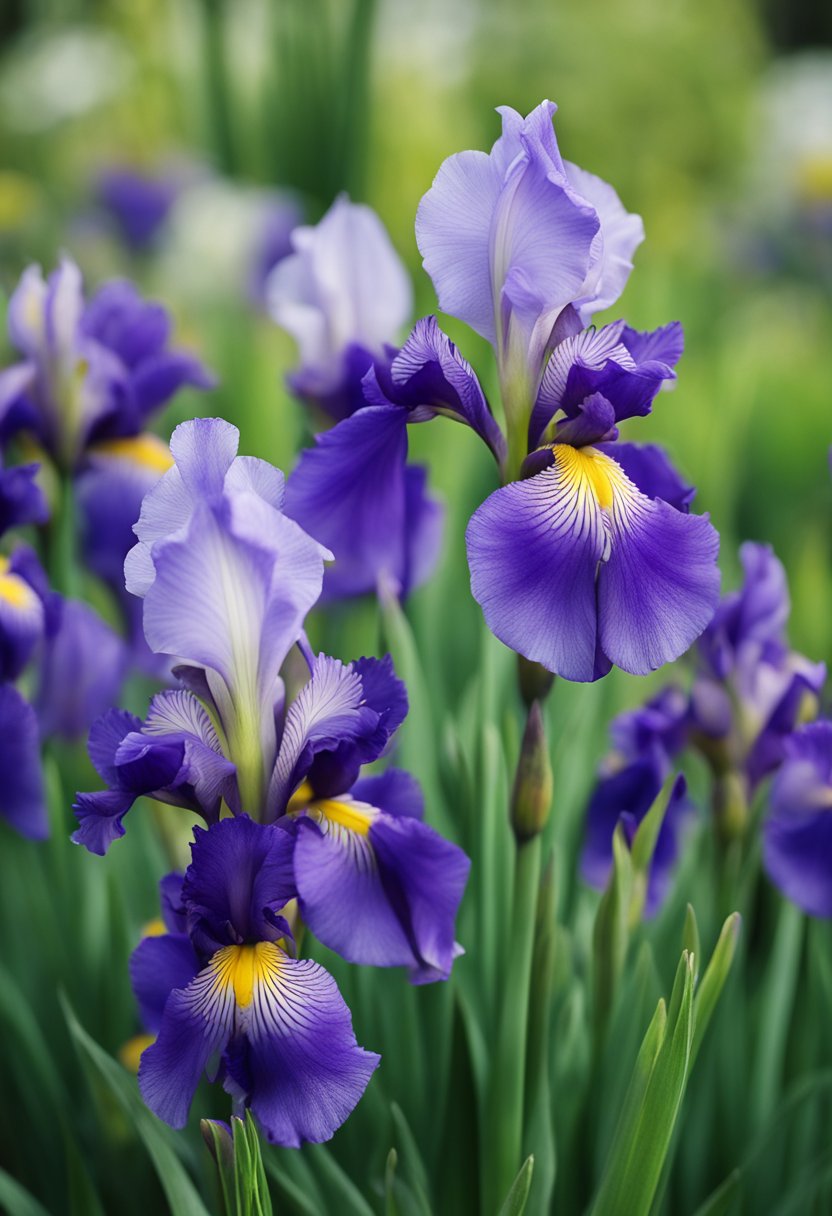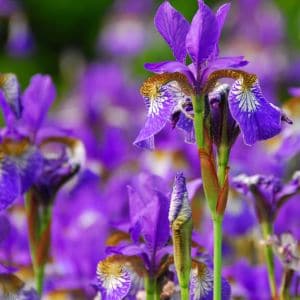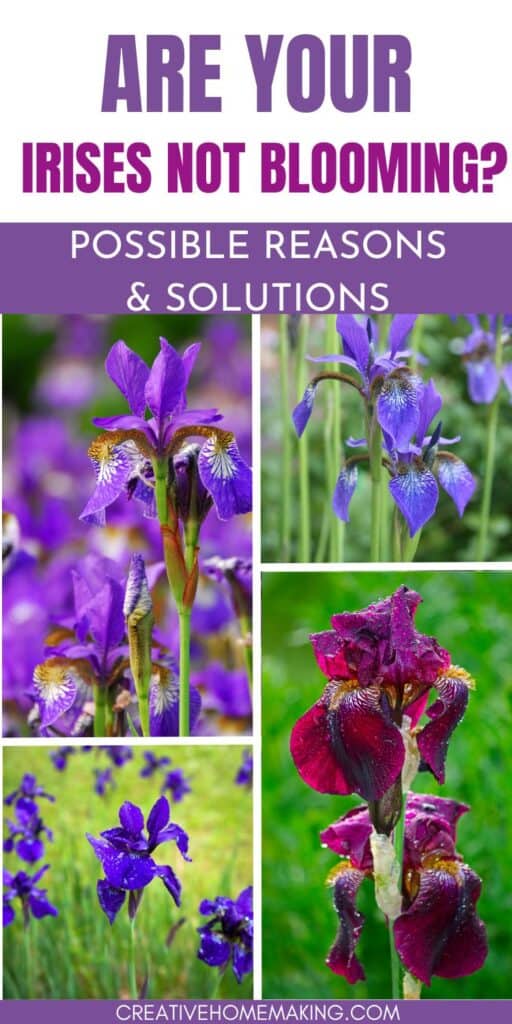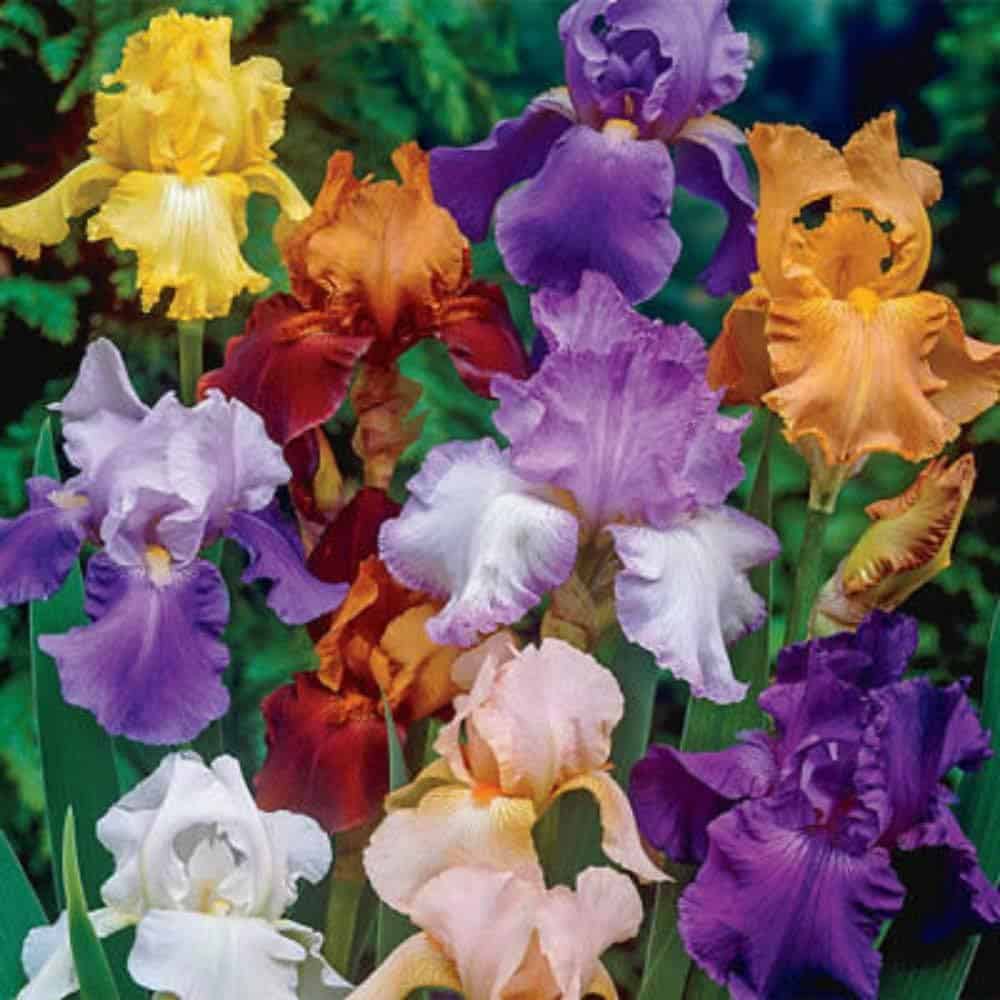Are your irises not blooming as they should? If you’re experiencing this problem, you’re not alone. Irises are a popular and beloved flower, but they can be finicky when it comes to blooming.
This post may contain affiliate links.
There are several reasons why your irises may not be blooming, and understanding these reasons can help you get your flowers back on track.
One common reason why irises fail to bloom is improper planting. Irises need to be planted in well-drained soil with plenty of sunlight. If they are planted too deep or in soil that is too wet, they may not bloom. Another reason for non-blooming irises is overcrowding.
If your irises are too close together, they may not have enough space to grow and bloom. Additionally, irises need to be divided every few years to prevent overcrowding.
Understanding Iris Biology
If you’re having trouble getting your irises to bloom, it’s important to understand the biology of these beautiful plants. Here are some key things to know:
The Iris Rhizome
Irises are perennial plants that grow from rhizomes, which are thick, fleshy underground stems. The rhizome stores food and water for the plant and produces new shoots and roots each year. It’s important to plant your irises in well-draining soil so that the rhizome doesn’t rot.
When planting your irises, be sure to position the rhizome just below the soil surface, with the roots pointing downward. If the rhizome is planted too deep, it may not receive enough sunlight to produce flowers.
Iris Species Varieties
There are many different species of iris, but the two most common types are bearded irises and Siberian irises. Bearded irises have a distinctive “beard” of short, stiff hairs on the falls (the lower petals).
Bearded Iris Mixed Colors 5 Bulbs Plant
They come in a wide range of colors, including purple, blue, yellow, and white. Siberian irises, on the other hand, have narrower leaves and smaller flowers. They prefer moist soil and can be grown in partial shade.
It’s important to choose the right variety of iris for your climate and soil conditions. Some types of iris, such as bulb irises, require a period of cold dormancy in order to bloom. Rhizome irises, on the other hand, can be planted in the fall or spring and will bloom in the summer.

Planting and Locational Factors
When it comes to irises not blooming, planting and locational factors can play a significant role. Here are some things to consider when planting and choosing the right location for your irises.
Choosing the Right Location
Irises require at least six hours of sunlight per day to bloom properly. Make sure to choose a location that receives enough sunlight and is not shaded by trees or other plants.
If you’re planting in a garden or landscape, it’s best to choose a spot that is well-drained and not too crowded. Overcrowding can lead to poor air circulation and increased risk of disease.
Planting Depth and Spacing
Planting depth and spacing are also important factors to consider when planting irises. The rhizomes should be planted just below the surface of the soil, with the roots facing downwards. It’s important not to plant the rhizomes too deep, as this can lead to poor growth and blooming. As for spacing, irises should be planted about 12-18 inches apart to allow for proper growth and airflow.
If you’ve recently transplanted irises, it’s important to give them time to adjust to their new location before expecting blooms. It can take up to a year for transplanted irises to bloom again. In the meantime, make sure they are receiving enough sunlight and are not overcrowded.
Soil and Water Requirements
Soil Quality and pH Levels
The quality of soil and pH levels play a crucial role in the growth of irises. Irises require well-draining soil that is rich in nutrients and organic matter.
If the soil is too heavy or clay-like, it can lead to poor drainage, which can cause the roots to rot. On the other hand, soil that is too sandy may not retain enough moisture, leading to dehydration of the plant.
The ideal pH level for irises is between 6.0 and 7.0. It is important to test the soil regularly to ensure that the pH level is within this range. You can use an inexpensive soil tester to determine the pH level of your soil.
If the pH level is too low, you can increase it by adding lime to the soil. If the pH level is too high, you can decrease it by adding sulfur.
Watering and Drainage
Watering and drainage are also essential factors for the growth of irises. Irises require consistent moisture, but they do not like to be waterlogged.
Overwatering can lead to root rot and other problems. It is important to water your irises deeply once a week, rather than giving them frequent shallow waterings.
Proper drainage is also important for irises. If the soil does not drain well, it can lead to waterlogging, which can cause the roots to rot. Adding mulch to the soil can help improve drainage and retain moisture.
Nutrition and Fertilization
If your irises are not blooming, it could be due to a lack of proper nutrition and fertilization. Irises require certain nutrients to grow and bloom properly, and if those nutrients are not present in the soil, the plant may not thrive.
The Role of Fertilizers
Fertilizers are an important part of iris care. They provide the necessary nutrients that the plant needs to grow and bloom. There are many different types of fertilizers available, but it is important to choose one that is specifically formulated for irises.
When choosing a fertilizer, look for one that is high in nitrogen, phosphorus, and potassium. These are the three main nutrients that irises need to thrive.
Nitrogen is important for leaf growth, phosphorus is important for flower development, and potassium helps with overall plant health and disease resistance.
Understanding Nutrient Needs
In addition to using the right fertilizer, it is important to understand the nutrient needs of your irises. Bone meal is a great source of phosphorus and can be added to the soil before planting. However, too much phosphorus can actually inhibit bloom production, so it is important to use it sparingly.
It is also important to maintain the proper pH level in the soil. Irises prefer a slightly acidic soil with a pH between 6.0 and 7.0. If the soil is too alkaline, nutrients may not be available to the plant, which can lead to poor growth and blooming.
Common Problems and Solutions
If you are experiencing issues with your irises not blooming, there are several common problems and solutions to consider.
Dealing with Pests and Diseases
Pests and diseases can cause your irises to stop blooming. Aphids and other sap-sucking pests can weaken the plant, making it more susceptible to disease. Root rot is a common disease that can affect irises and cause them to stop blooming.
To deal with these issues, you should regularly inspect your irises for signs of pests and disease. If you notice any problems, treat them promptly with an appropriate pesticide or fungicide.
Environmental Stress Factors
Environmental stress factors such as drought, temperature extremes, and lack of sunlight can cause irises to stop blooming. If your irises are not getting enough water, they may become stressed and fail to produce blooms.
Similarly, if they are exposed to extreme temperatures or freeze, they may not bloom. Lack of sunlight or dappled shade can also prevent irises from blooming. To address these issues, make sure your irises are planted in an appropriate location and are receiving the proper care.
Improper Care Practices
Improper care practices can also cause irises to stop blooming. Overcrowded irises and unhealthy rhizomes can prevent the plant from producing blooms. If your irises are overcrowded, divide them and replant them in a new location.
If the rhizomes are unhealthy, remove them and replant the healthy ones. Additionally, improper planting can cause irises to stop blooming. Make sure you are planting your irises at the appropriate depth and in well-draining soil.
By addressing these common problems and solutions, you can help your irises bloom and thrive. Regular inspection and care can go a long way in keeping your irises healthy and beautiful.
Encouraging Healthy Blooms
If you’re an iris lover, you know how disappointing it is when your irises fail to bloom. But don’t worry, there are a few things you can do to encourage healthy blooms in your iris plants.
Dividing Iris Clumps
One of the most common reasons irises fail to bloom is overcrowding. When iris plants become too crowded, they compete for nutrients and water, which can result in stunted growth and a lack of blooms. To prevent this, it’s important to divide your iris clumps every few years.
To divide your iris clumps, wait until the foliage has died back in the fall or early spring. Then, carefully dig up the clump and separate it into smaller sections, making sure each section has a healthy rhizome and a few leaves.
Replant the sections in a new location, spacing them at least a foot apart.
Optimal Conditions for Blooming
Irises need the right growing conditions to produce healthy blooms. They prefer full sun or at least six hours of direct sunlight each day. They also need well-draining soil and regular watering, especially during their growing season.
To encourage reblooming, it’s important to deadhead your iris flowers as soon as they start to fade. This will prevent the plant from putting energy into seed production and instead encourage it to produce more blooms.
Finally, make sure your iris plants are getting the right amount of nutrients. Fertilize them in the spring with a balanced fertilizer, and again in the fall with a low-nitrogen fertilizer.
Frequently Asked Questions
Why might my irises not be flowering?
There are several reasons why irises may not be flowering. One common reason is that they are not getting enough sunlight. Irises need at least six hours of direct sunlight each day to bloom properly.
Another reason may be that they are not getting enough water. Irises need to be watered deeply once a week, especially during dry spells. Overcrowding can also prevent irises from blooming, so make sure they have enough space to grow.
What are the signs that an iris is about to bloom?
The signs that an iris is about to bloom include the appearance of a flower spike, which will grow taller and thicker as the bloom develops.
The buds will start to swell and eventually open up, revealing the beautiful petals inside. You may also notice a sweet fragrance coming from the flowers.
What steps can I take to promote blooming in irises?
To promote blooming in irises, make sure they are getting enough sunlight and water. Fertilize them with a balanced fertilizer in the spring and fall.
Deadhead the spent blooms to encourage more blooms to form. You can also divide your irises every few years to prevent overcrowding and promote healthier growth.
What should I do if my potted irises aren’t blooming?
If your potted irises aren’t blooming, make sure they are getting enough sunlight and water. Fertilize them with a balanced fertilizer every two to three weeks during the growing season. You may also want to consider repotting them into a larger container with fresh potting soil.
What is the best time to divide irises for optimal blooming?
The best time to divide irises for optimal blooming is in late summer or early fall, after they have finished blooming for the season. This will give them enough time to establish their roots before the winter months.
How can I provide proper nutrition to encourage my irises to bloom?
To provide proper nutrition to encourage your irises to bloom, fertilize them with a balanced fertilizer in the spring and fall. You can also add compost or well-rotted manure to the soil around the plants. Avoid over-fertilizing, as this can lead to excessive foliage growth and fewer blooms.
Follow my gardening board on Pinterest.




